What you really want is to get photos off your camera and into the world, to a make your memories real. You take photographs because moments matter—and scrapbook them so you don’t forget why. The creative process elevates that desire to a joyful, fulfilling experience.
But if our needs are ultimately simple, why do we perpetually feel so overwhelmed? I believe it’s because we’re attempting to apply outdated scrapbooking expectations and “rules” to today’s world. Even those who already embrace a slower, more intentional lifestyle have trouble keeping pace with the sheer quantity of photos.
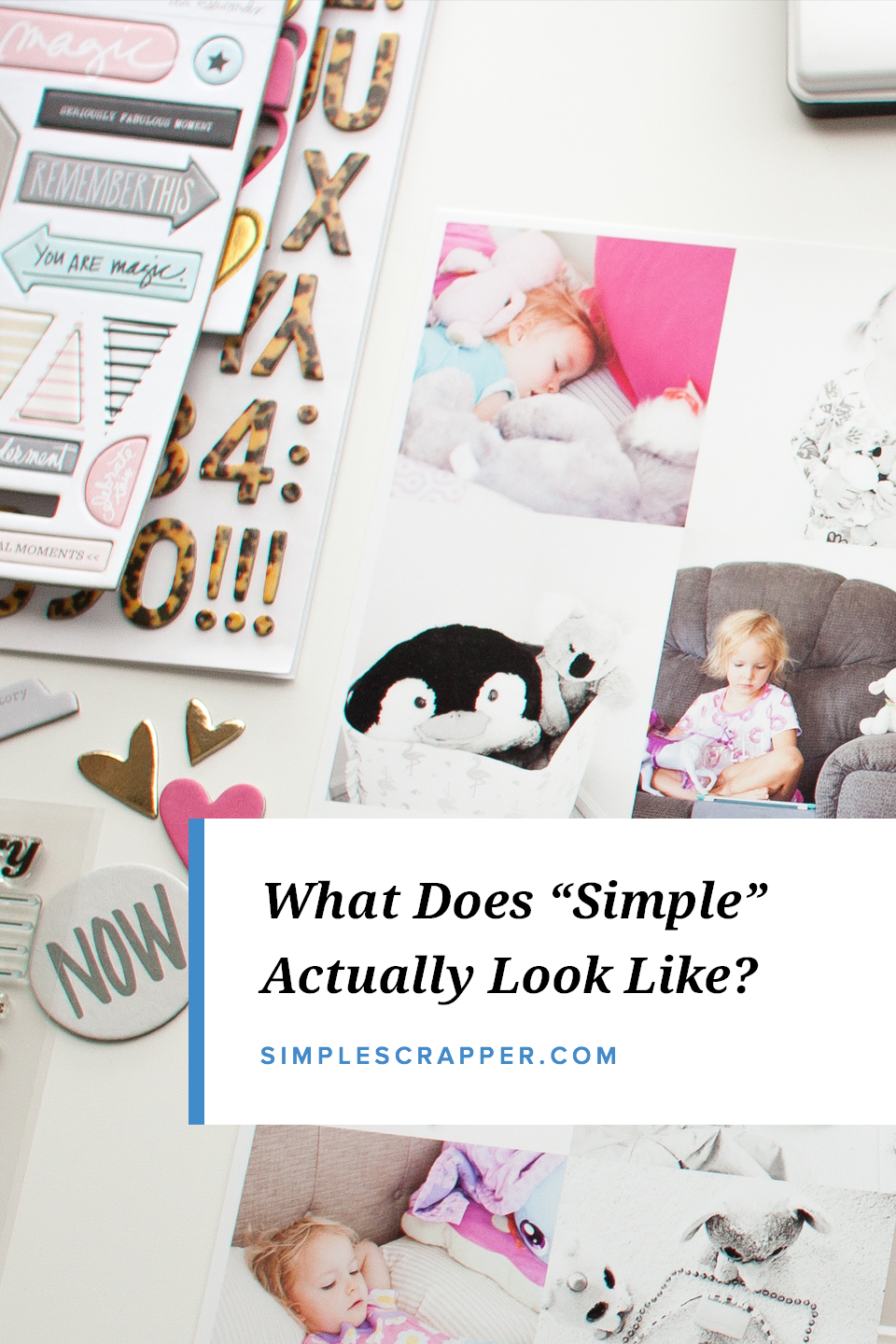
In Nobody Wants to Be a Rebel I explained why it’s time to rewrite the rules of scrapbooking. But what actually happens when we do that? Today I’d like to paint a picture of possibility for you and illustrate what modern, simple scrapbooking actually looks like.
1. It starts with photos.
Scrapbooking is by default photo-centric, but the rapid influx of photographs today means that we must expect and plan to spend time doing image management. The system for handling photos is no longer simply a stepping stone for getting them into albums, but is instead a cornerstone component of the scrapbooking process.
Because the vast majority of those images will never be “scrapbooked” in the traditional sense, we must look upon our digital photo libraries as the most complete record. Photo management is scrapbooking.
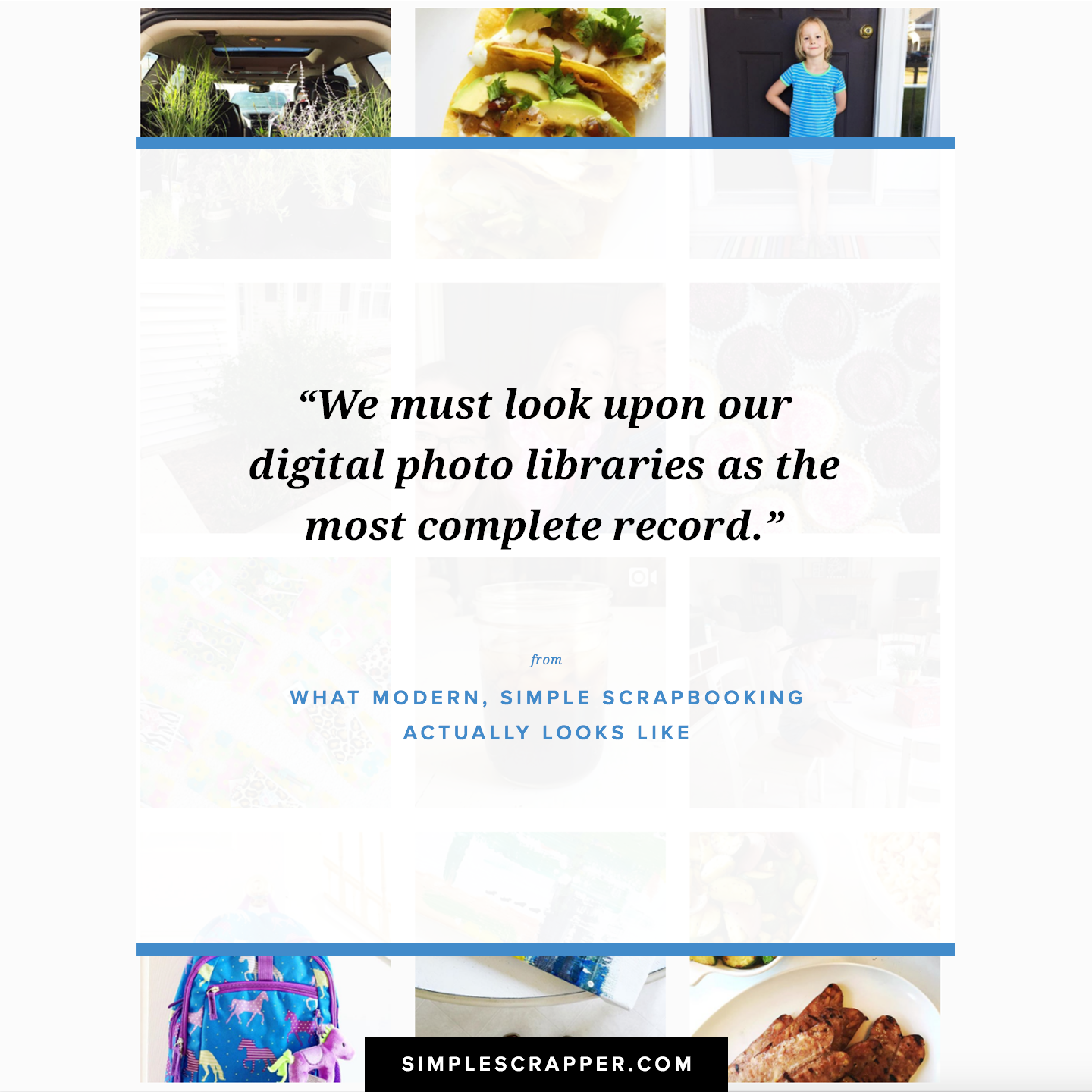
An extension of this concept is continual attention on the photo library as the best and most meaningful source of inspiration for taking a creative next step. But as a consequence, the photos do not themselves represent a checklist of pages to create. The onus is on the memory keeper to be selective, to curate highlights of their family’s story whether in albums, photo books, or on the walls of a home. Visible evidence of prioritizing photos includes:
- Reducing creative expectations or taking on fewer projects to preserve time and energy for photo management.
- Routinely redirecting attention towards learning, maintaining, or improving systems that support the photo library.
- Celebrating photos in all forms and formats without judgement of whether it “counts”. It all counts.
2. It embraces impressionism.
In The Scrapbooking Rule You Must Break I introduced the idea that, out of necessity, we are 21st century impressionists. Following in the footsteps of renowned 19th century painters, today’s scrapbookers paint pictures of life “with broad strokes” that capture as much emotion and meaning as they do reality. Because there are more photos and stories than we could ever scrapbook, we must value how each glimpse documented adds to the big picture.
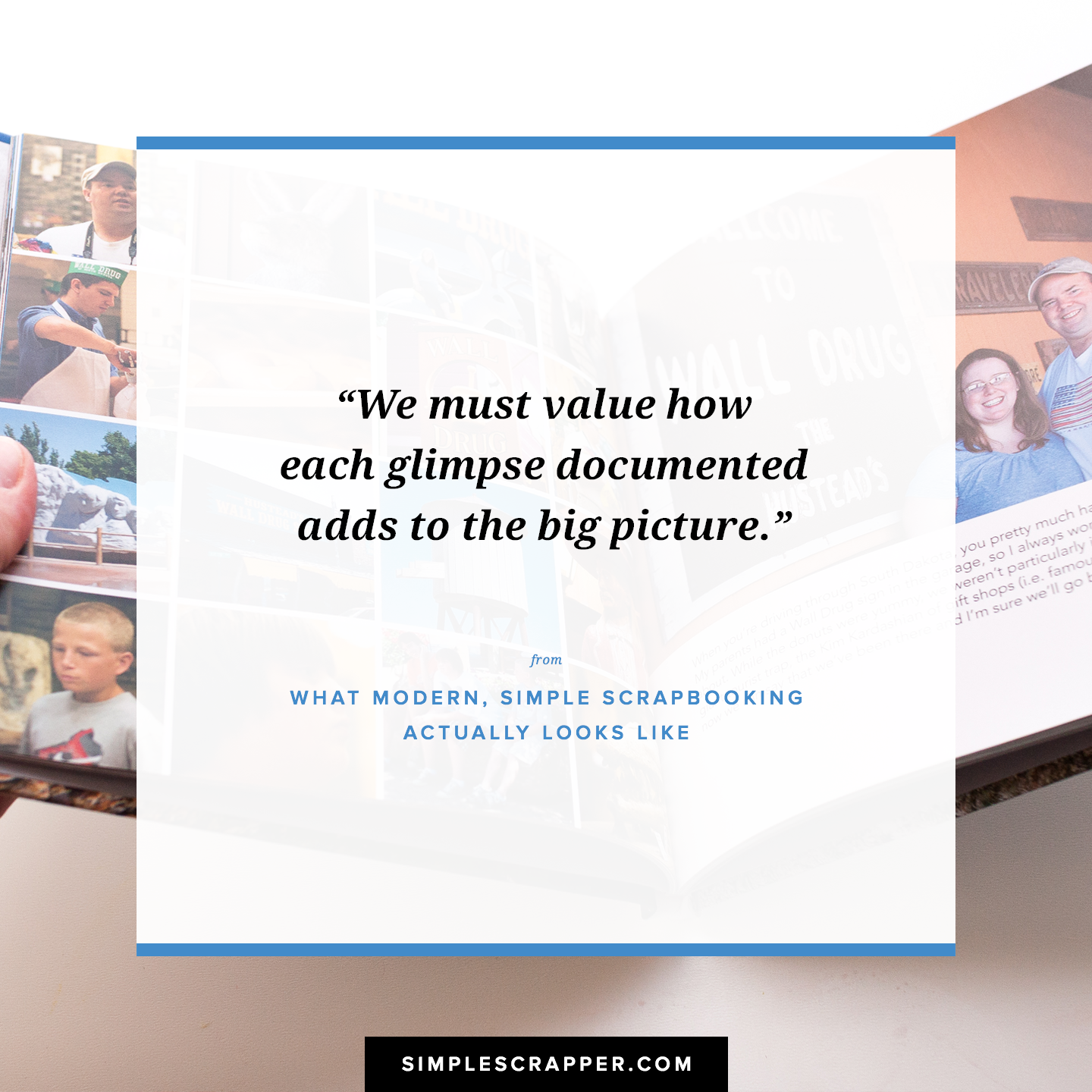
The impressionist mindset goes beyond a rejection of “caught up” though, as it seeks opportunities that purposefully simply the process while retaining a sense of depth. It invites the scrapbooker to look at her hobby more holistically to ensure that it’s really meeting her needs. Visible evidence of impressionist scrapbooking includes:
- Choosing a project format for each story that maximizes enjoyment and practicality.
- Balancing attention between everyday details, big milestones, and meaningful stories.
- Allowing words and visual symbolism to take the place of scrapbooking every photo.
3. It focuses on stories.
A direct consequence of not scrapbooking everything is a natural emphasis on storytelling. But whereas the concept of impressionism broadly calls our project and process decisions to demand balance, a focus on stories counters a more specific unwritten “rule” of the hobby: that our objective is to capture the facts of each life event. Thus a story-first approach to memory keeping doubles down on the impressionist directive of adding meaning to the picture, making it worth it’s own point.
More plainly, using stories rather than events as a basis for scrapbooking makes going deeper more intuitive. By asking “why does this matter?”, examining personalities, or discussing feelings, we invite our brains to do what they’re best at: make connections. And while facts are certainly still important, we must use storytelling to add a deeper level of satisfaction when we can’t possibly capture it all.
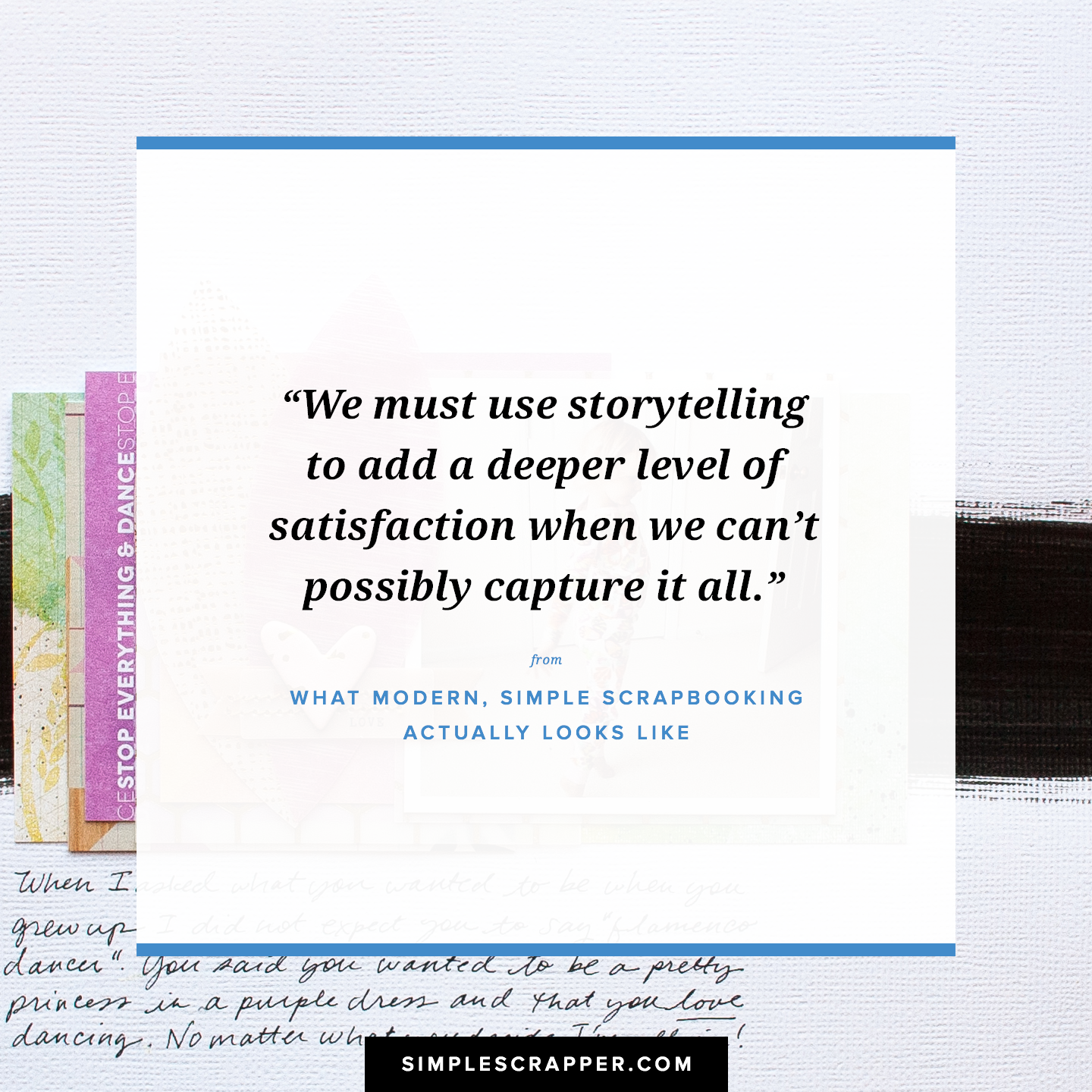
But let’s be clear: focusing on story when creating scrapbook pages and projects don’t necessarily mean more journaling, though of course it can. It’s about looking first to the underlying meaning to guide the visual and written elements of your creative effort, to maximize the effort you’ve invested. Visible evidence of story-first scrapbooking includes:
- Identifying why a photo (or group of photographs) is significant or meaningful to you.
- Including more feelings and memories along with the facts in your scrapbook journaling.
- Finding the through line between photos from different time periods or places.
4. It is personalized.
We have more options than ever for documenting our memories, but instead of focusing on what works best I see too many scrapbookers attempt to do it all. I understand the temptation to try new approaches (and I do recommend testing the waters), but too much dabbling only contributes to feeling unfocused and overwhelmed.
Instead we must leverage the array of choices to intentionally personalize our hobbies. If impressionism means letting go of capturing every detail, personalization is the selective re-addition of what matters most to you. You get to precisely determine both what your finished projects and the process of creating them looks like, down to how much is “enough” for you.
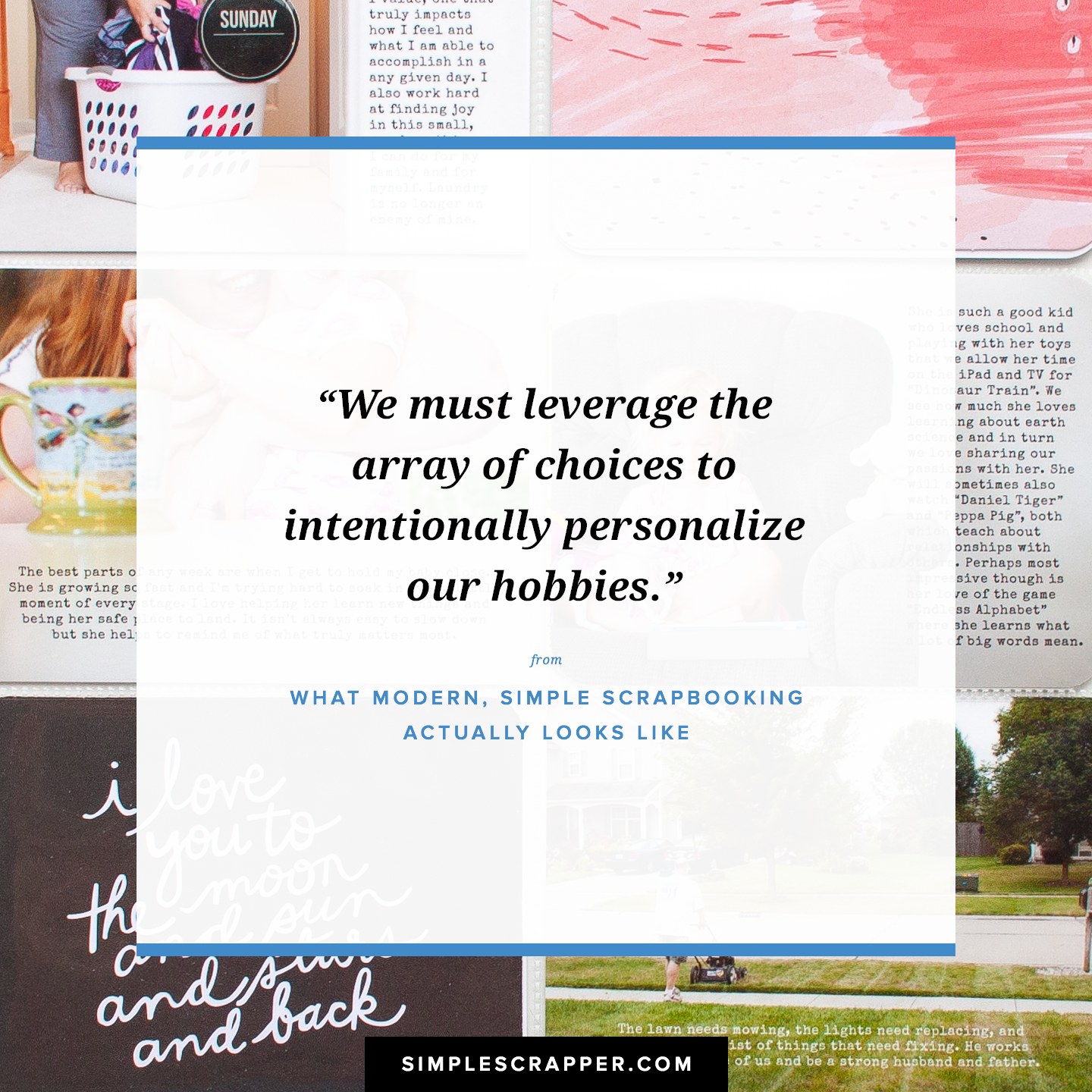
We all naturally desire personalization and often take steps toward it, but it is here where “the rules” often prompt second-guessing. That’s why I spend so much time writing about, talking about, and leading you through the process of making your hobby a perfect-fit. I want to give you both the tools and the encouragement to genuinely trust that you know what’s best. Visible evidence of personalization includes:
- Working in continuity from a clear-but-flexible framework in lieu of always seeking the greener grass.
- Choosing not to use a project format if it doesn’t work for you, even if you think the products are pretty.
- Listening to yourself (what you know, your gut/intuition) when making each project or purchase decision.
5. It is guided by life.
Each month, season, and year are different. There are ups and downs, ebbs and flows. Your interest in and motivation for scrapbooking will shift along with the tide of your life. We must look at our albums as treasure chests, ready for each gift we are able to add, and stop looking on them as unfulfilled obligations.
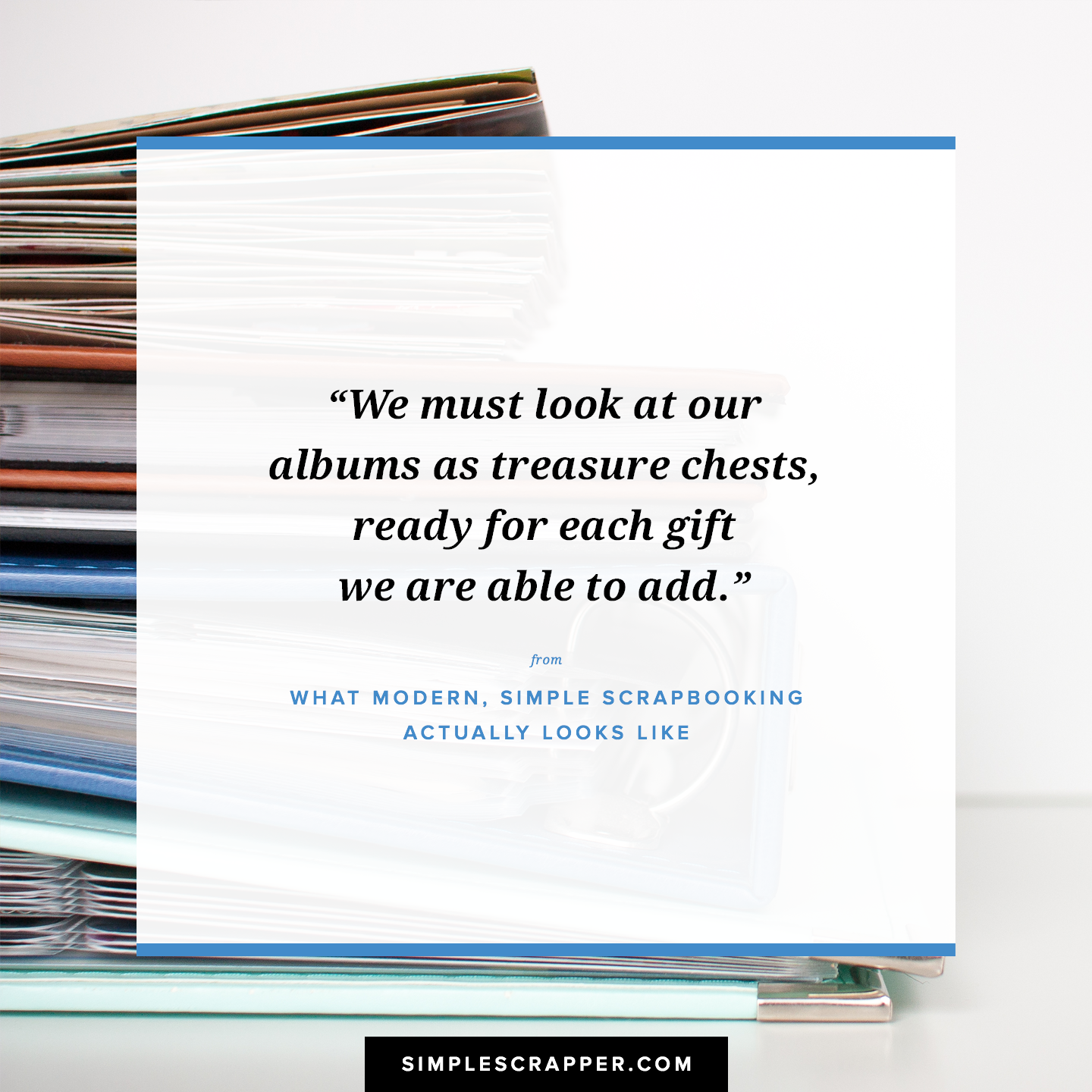
When you let your life gently and intentionally guide your scrapbooking, you’ll find creative flow with less effort. And when projects have that natural, perfect-fit feel you will be more likely to finish them. Instead of paddling against the current much of the time, you can let the current make it easier to move forward.
The reality of this means that sometimes you will scrapbook a lot and at others you won’t create anything at all. During some seasons you will invest your energy into projects that require thought and details and during others you will find solutions that are good enough. Visible evidence of letting your life guide your hobby includes:
- Accepting that you are no less a scrapbooker if you don’t scrapbook for a period of time.
- Choosing to scrapbook longer time scales with a smaller or more condensed approach.
- Taking time each season to align your mindset, plans, and expectations with your life.
Scrapbooking in the modern era is not one-size-fits-all. Your projects can be graphic or fancy, paged or pocketed, fast or thorough, frequent or rare—but it’s when you start writing your own rules that memory keeping can truly be simple.
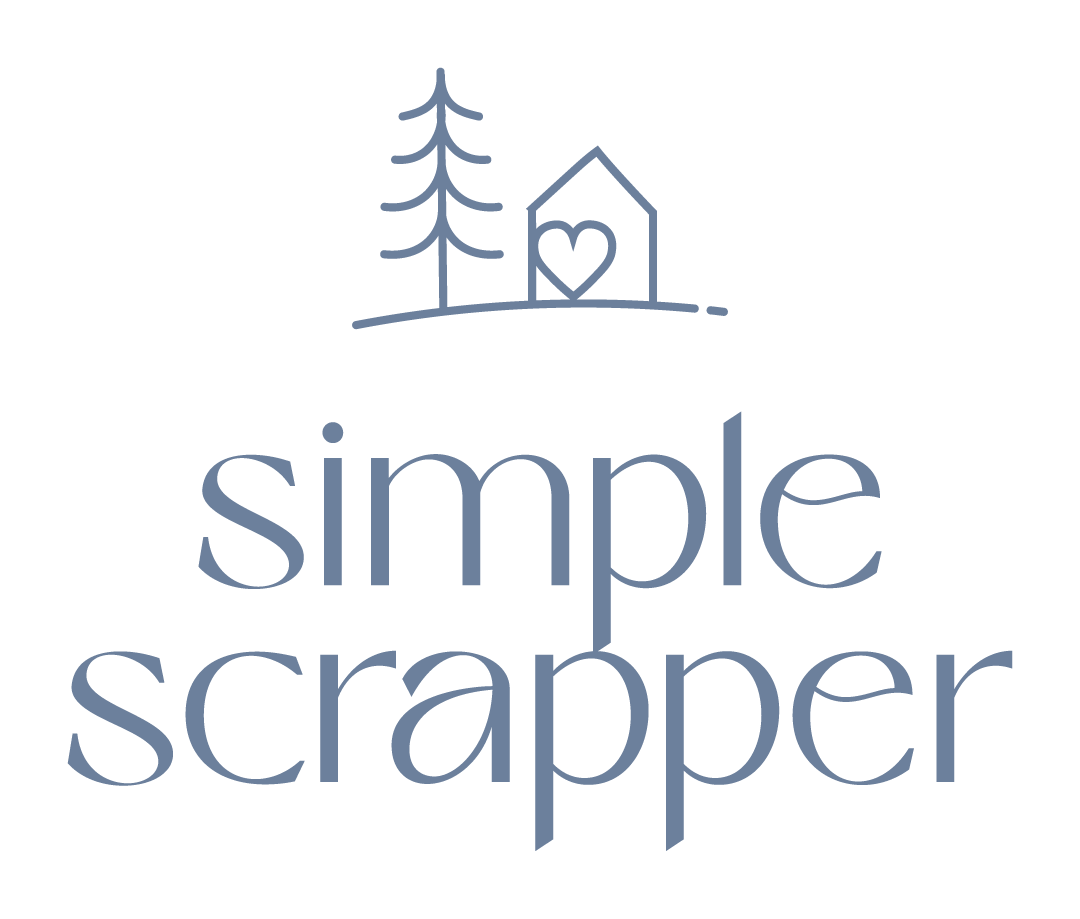
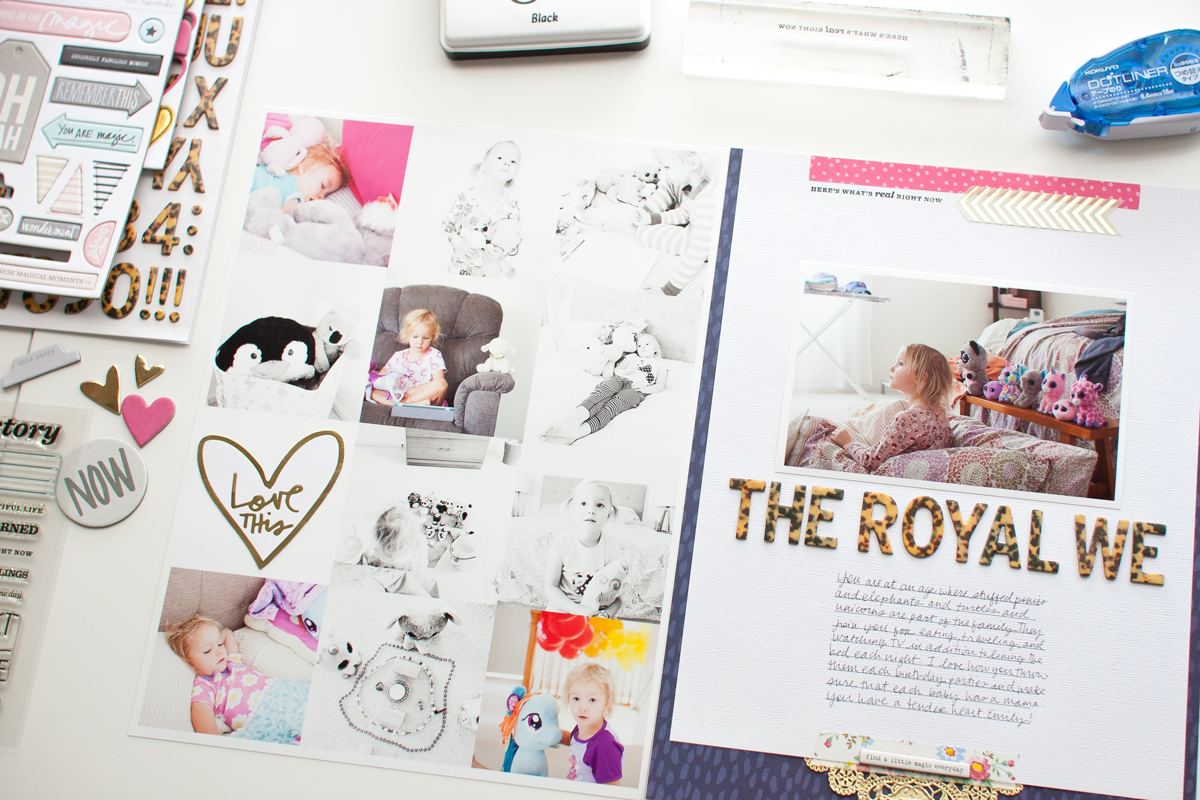
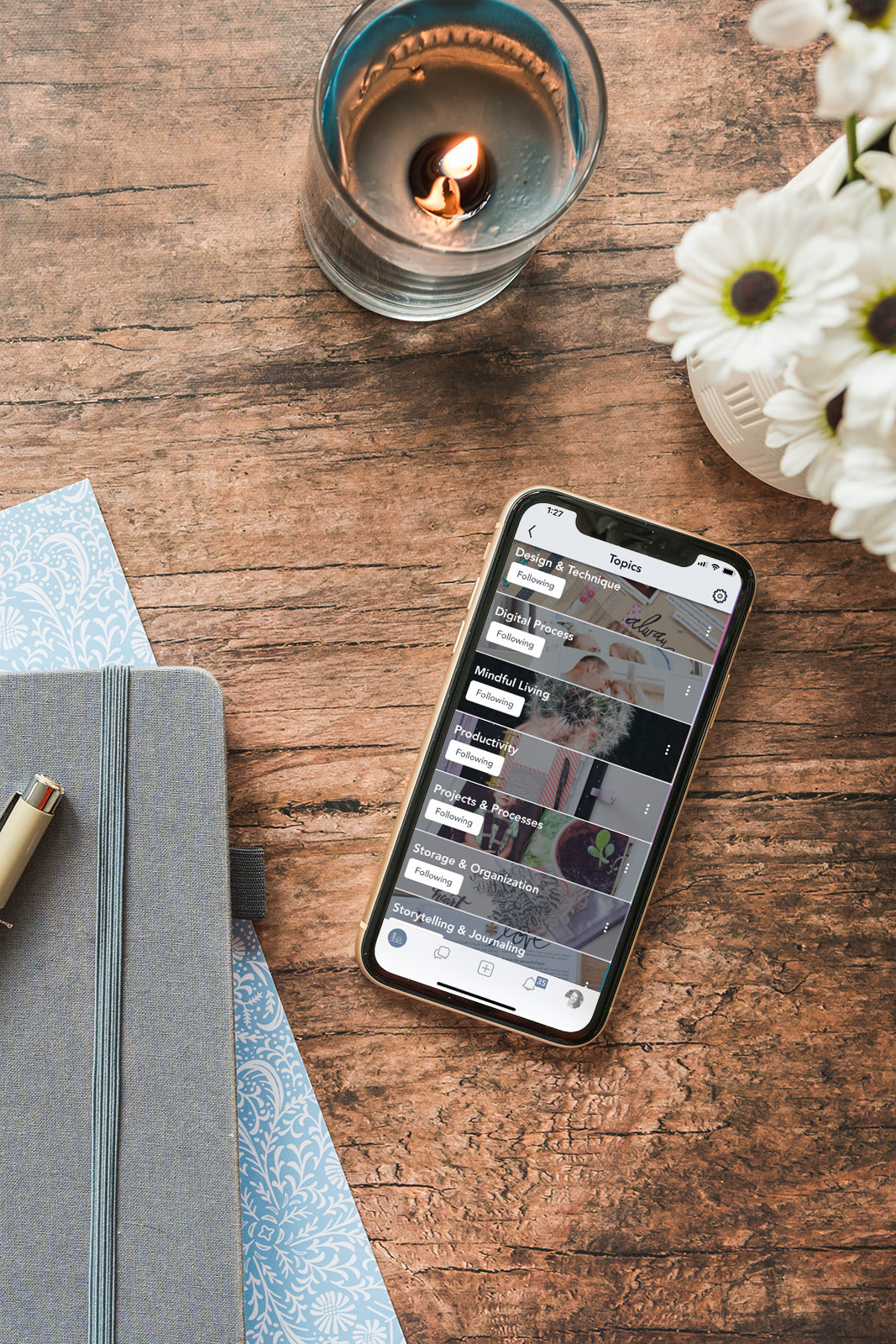
“Your interest in and motivation for scrapbooking will shift along with the tide of your life. We must look at our albums as treasure chests, ready for each gift we are able to add, and stop looking on them as unfulfilled obligations.”
This resonates with me greatly as it is TRUTH. That’s right, all caps: TRUTH. Unfortunately it has taken me several years to realize this, but fortunately I can now relax my obsession with trying to get it all done because I ‘have to’ or ‘need to’. That mindframe has been driving me batty the past couple of years – not because of any outside expectation from my fellow scrappers, but because of my own perception of what I need to be doing with all of these photos I have.
I have purposely been pulling away from that mindframe this summer and find that I am again enjoying the process and my creative muse has been active rather than dormant. I am again happy with my creativity in this season of life.
I have loved seeing you blossom in our community Kim. Thanks so much for sharing!
I agree with so much of what Jennifer has written but I am also a bit opposite from the article’s discussion. I want to scrapbook the stories and emotions but am overwhelmed regularly in the details of the intent. For many pics I no longer remember the story to, nor (especially so) the emotions during or “behind” the scenes, but I love the pic. Sometimes, just for fun I want to scrapbook the pics that I love and use the embellies just because the embellies and the pics are pretty and they make me smile. Basic who what when where can be enough. No story. Just what will bring a smile. And that will be good enough.
I realize it just then becomes a work of art and I have resisted that mindset for many years because of the guilt of not telling the story. I am realizing art for the sake of making something special is worthwhile for me and I am learning to embrace it.
All the pre-planning and “intentional” scrapbooking seems to be the “rule” I give myself permission to break. It is bogging me down and keeping me from scrapbooking. Failure to tell the story still feels like failure. Sometimes the events are enough to scrapbook, use the embellies and pics, smile at the fun of just looking and reliving the event and then move on.
No pressure, no expectation to “document life” for the next generation.
Hybrid scrapbooking: scrapbook l.os mixed with photo page spreads works and takes away the overwhelmed feeling that leads to procrastination and guilt of not “memory keeping”.
Thank you Mariane, for introducing an important counter point. The emphasis on storytelling within the online community can increase feelings of guilt, particularly if it isn’t always fun for you. I will make sure to address this in my book.
With life pulling in so many different directions, sometimes scrapbooking takes a back seat or is done quickly for a gift or just fun, without a lot of forethought. Thanks Jennifer, for the insight. ;o)
Really nice column, thanks. It would have been nice to see just a few sample photos to illustrate points.
Thanks for the feedback Jan. Do take a look at the quote images as each was chosen to represent an aspect of the point.
I agree with all what Jennifer said. My situation is a bit different…(So my leverage of choices is different… (sorry for my English appearance or leverage, I’m French and I write with my French-english dictionary) lol
I will give you my opinion on what I just read from Jennifer…. I’m 73 years old so I don’t have time to scrapbook so many photos and scrapbook many albums. So, I will do my best to make an album for my daughter and try to make one for each of my 3 grand kids.
I won’t bother making one for my brothers and sisters…. If they want a copy of my Before your story (I have included some photos of them and my parents in it…) they just have to ask my daughter…..
After that I will do albums with some stories of the many photos I got, they are not organized yet. Or maybe I will scan all of them to put on a new hard drive… to keep; (always depend of my health…)
I decide I will have fun doing layouts and maybe project life pages with the best photos I enjoy.
If I can I might do one album of the cottage I earn since 1974, I have many photos and we pass a good time there each weekend and vacancies… I sold it three years ago. Also, I still have my house to keep up.. Maybe one album for all the Chrismas and New Years holidays.
No one of us, have the same needs depend on how old we are…. I will do the stories that are important and give me happiness… They will be placed in an album all mixed… if someone want to continue after me… that will be ok. Maybe Vanessa, my grand kid, she is 27. She love what I do…
I always look at my albums as treasured chest since I scrapbook… I will continue that way…
That’s it, it’s about what I have like rules, no obligation.. just have fun adding new treasured pages or as gift. it’s when you start writing your own rules that memory keeping can truly be simple and joyful.
Thank you for sharing your seasoned perspective. Sometimes we get lost in the keeping up that we forget to look for the intersection between joy and legacy.
Love your “joy vs legacy” statement. Resonates with me as did the treasure chest concept.
Thank you for guiding my motivation as I reframe my love for scrapbooking.
Carmelle, I love this perspective too. ;o) I won’t be leaving a bazillion scrapbook albums behind, just many that share the beauty, the fun and things in mine and my family’s lives. But there will still be a bazillion pictures! LOL
I grew up with photo albums of the 40’s & 50’s. I LOVED the black paper background, making the photos themselves the center of attention. My mom wrote a brief description of the photo(s) by hand and in white ink.
I have memories of going through old photo albums with my grandma, too. She fleshed out the stories behind the photos.
As a child/teen, I’d sit for hours looking at the albums that showed my infancy, friends, and iconic scenes snapped in an instant and reminded me of a particular event.
Keeping our albums simple, but meaningful is the greatest gift we can give those who follow us.
“Keeping our albums simple, but meaningful is the greatest gift we can give those who follow us.” >> Beautifully said. Thank you for sharing your experience!
I really really like this post and look forward to your book. The quote about the treasure chest resonated with me a lot because I find in the moment that I don’t necessarily “like” a layout — not enough embellishments, color combo not right, papers slightly off — but when I look back at the pages in my album after letting them sit for a month or two, I LOVE THEM. Like, they make me giddy, I’m so happy to just flip through them. I no longer care that I don’t have any enamel dots on there or that I didn’t find the perfect shade of purple to match my daughter’s dress. It feels like a true treasure that I have documented something, and I don’t care anymore that I don’t have every picture caught up. I am just happy to have something to look at and fill me up again. So not only is my album a treasure chest ready for more gifts to be added, it is already FULL of gifts waiting to be enjoyed.
I also liked what you wrote about seasons of scrapbooking. A few years ago (as part of Stacy Julian’s Twelve class), I started keeping track of how many layouts I complete a month. As part of that, I realized that I tend to make more and finish more at the end of the month than at the beginning. That has helped me block off scrapbooking time at the end of the month, with the knowledge I will be more productive then, and not worry so much about not having “time” at the beginning of the month. I have also noticed that sometimes I’m really in the zone to make the foundations for a page, but not finish it, and other times I have no inspiration for starting new layouts, but lots of oomph to finish what I’ve already started. Both aspects of my scrapbooking satisfy me and make me happy, but when I try to force myself to do one, when I’m in the other zone, I stagnate and get frustrated and feel like I never finish anything. (Hello, December Daily from 2013, 2014, and 2015 sitting on my table!)
Thank you for writing this. I agree with the first poster that you have touched on the TRUTH!
Really appreciated this article and the the responses. They’re all very encouraging as I unlock the purpose and art of scrapbooking – for me. I’m still relatively new at it even though I’ve completed a few pages now. My craft-loving grandaughter (16) loves to see the latest photos I’m working on: usually of one of my 5 grandies. Journalling was an enormous stumbling block till I read it’s about how much or how little I feel able to share as the author. Phew! Now I’m embracing the concept that my pages are a taonga (a treasure) and koha (gift) to my family. The pages may be flawed or lacking but they are my gift of love. Thank you 🙂